|
|
|
|
Hyrum Corry Perkins
&
Mary Kisten Adams Perkins
|
|
|
Treasured Citizens of San Juan County, Utah
|
|
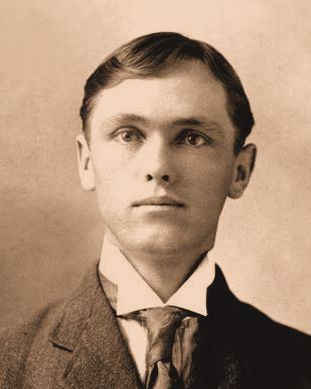 |
Hyrum Corry Perkins
&
Mary Kisten Adams Perkins |
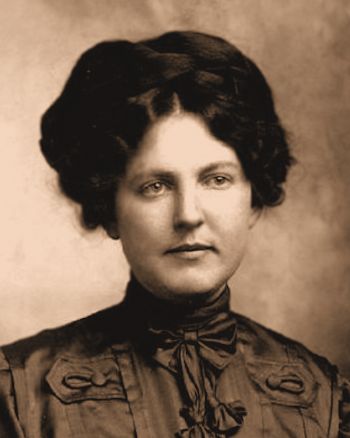 |
|
Brigham Young High School
Class of 1907 & 1911
|
|
|
|
Perkins Family History: From Peregrin to Perkins
The name Perkins was originally Peregrin, or Pilgrim, meaning migratory, or travelers in foreign lands.
William Peregrin, a coal miner in Wales, joined the Church of Jesus Christ of Latter-day Saints along with his family and some of his relatives.
John Taylor, a latter-day apostle and future president of the Church, served a mission in Wales and spent a lot of time in the Peregrin home.
At John Taylorís suggestion, they changed their name from Peregrin to Perkins when they migrated to America.
A calling to San Juan
The Perkins family came to America and settled in Cedar City, Utah. They were called to the San Juan Mission in a conference.
Brothers Hyrum, Corry and Benjamin Perkins were known as the blasters and the blowers on the San Juan mission because of their experience with dynamite in the mines in Wales. They helped build roads and blasted in the Hole-in-the Rock country to make trails for the wagons.
Corry Hyrum Perkins
Corry Perkins was born on January 30, 1885 in Bluff, Utah. He was raised in Bluff in a log cabin. His father was Hyrum Mathew Perkins, one of the blasters from Wales. His mother was Rachel Maria Corry Perkins.
When Corry was 6 or 7 years old his job was to herd the family's milk cows and keep them out of the alfalfa fields in Cow Canyon.
Corry was musically talented and played the violin in an orchestra, he also played in a harmonica band led by his father.
He graduated from the 8th grade in Bluff, Utah in 1903. He went to Brigham Young High School in Provo, Utah, where he saw a basketball for the first time. He learned the game and played guard for the "White and Blue" (the name of the team back then). He played on the high school varsity team for three years, then played on the BYU team in 1907. It was common practice for BYU to welcome top high school talent to the University squad. Corry was a starter and a dependable player in his year on the BYU varsity team.
One of his greatest thrills, he told his family, was when his team won a hard fought game where he made the last basket that won the game. He was carried around the playing floor by his teammates!
Kisten, his future wife, was in her first year at BYH in 1907, and cheered at the game.
|
|
|
|
Brigham Young University Basketball Team of 1907 Pose With Trophy Cup.
Corry Perkins is standing, back row, last on right.
This previously unknown photograph is owned by the Perkins family of Blanding, Utah. While we have not yet been able to specifically identify each player in this photo, the top players on the team in 1907 were: Henry Rose, Forward, Inverury, Utah '07; Ellis F. Chamberlain, Forward, Provo, Utah '09; Homer Christensen, Center, BYH '09; Hyrum Corry Perkins, Forward or Guard, Bluff, Utah '07, J. Hamilton Gardner, Forward, Lehi, Utah '07; Robert J. Evans, Lehi, Utah, Guard or Forward '07; Ernest M. Greenwood, Guard, Inverury, Utah '07. The coach in 1907 was Clayton Tryon Teetzell, famous University of Michigan athlete who went from BYU to UAC in Logan from 1909 to 1916 as Director of Physical Education.
More about 1907 BYU Basketball Season
|
|
In 1907, after graduating from Brigham Young High School, Corry was called to New Zealand and served there for over four years.
On the ship to New Zealand there was a professional wrestler who challenged anyone to a match for money. Corry was convinced to accept the challenge and had just a few days to prepare. He practiced hard with much advice from men on the ship. The professional wrestler was big and fierce looking, with a beard and a mustache that curled up at the ends. After a long, strenuous match, Corry won, but said that he walked like an old man for weeks afterwards.
In New Zealand, Corry and his companion rode ponies to get to the villages. The ponies were good swimmers and could be ridden to other islands. After such a trip to another island, the meeting was over and the tide had come in making the distance too long for the horses to swim with riders and a friendly boatman offered to take them across the water to their island base. The horses swam alongside the boat.
|
|
|
Suddenly, the ponies were attacked by sharks swimming swiftly toward them. Before the islander boatman could unwrap his rifle from the waterproof wrapping, a shark struck, tearing off a leg from a fear-crazed horse. They cut the horse loose but not before a bullet was fired into its brain.
More sharks gathered and were in a feeding frenzy. The rifleman shot at the sharks and the gunshot sharks became the prey of the others. During the feeding orgy, the men were able to calm the other bucking, screaming horse and rowed to safety.
Corry loved the Maori people. He spoke their language fluently. He lived with them and ate the food they ate, which was most often a fish stew. They sat around a huge pot and dipped the fish and vegetables out with two fingers.
|
|
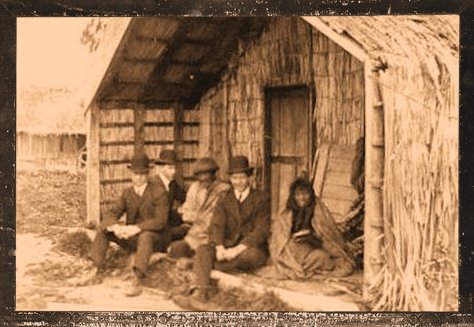 |
Missionaries visit Maori people.
Photo of Maori War Dance. |
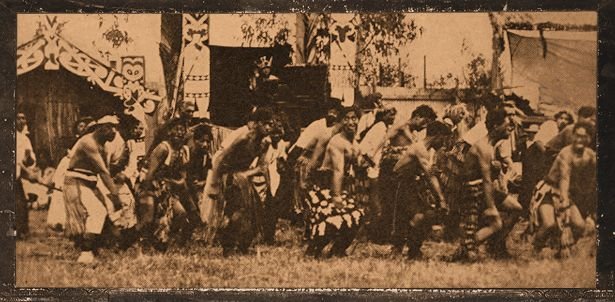 |
|
Corry learned island dances and songs. The Maori men's faces were tattooed and during their war dances they made hideous grimaces, part of their war dance to intimidate their enemies.
Life in Bluff
After his mission Corry came back to San Juan County, his family, his Piute and Navajo friends and to court and marry Kisten Adams.
Corry and Kisten lived in Bluff where he worked with his family ranching sheep and cattle, battling rustlers, homesteaders, drought, and government laws.
When the coupleís first daughter, Merlene, was fourteen months old, Corry was called to serve a short mission in Kansas City, Missouri.
Corry was fluent in the Piute language as well as the Navajo language and could converse with the Indians of San Juan. He considered them his friends and valued that friendship.
He had learned during four years in the mission field, that though people may speak and look different, they are people to be esteemed. He lost any fear of the Indian people and enjoyed their association in the cow camps and in town.
|
|
|
He was completely unprepared for a life-threatening episode after some Indian trouble in Bluff. Piutes were burning bridges, cutting telephone lines, and shooting cattle. The sheriff sent word to the cattlemen with stock on Elk Mountain to remain at home, because of the threats the Piutes were making on the settlers.
Corry thought that advice was ridiculous. The Piutes were his friends. They came to the Perkin's cow camp many times bringing venison. They shared meals and persuaded Corry to play the harmonica. They asked him to tell them stories of the Maoris and sing the songs of the islands.
He needed to care for his cattle on Elk Mountain and was just starting up the other side of Cottonwood Wash when 17 Piutes rode out of the trees and surrounded him. Threats were made. One of the Indians hit Corry across the face with a quirt and put his loaded rifle against his mid-section.
Posey and Dutchie, Piute friends to the bilagaanas, spoke up for Corry and said that Corry never carried a gun and had always been their friend.
Posey told Corry to go on to the mountain and that he wouldn't be bothered again. Corry started on his way and was stopped by the Utes twice more and threatened with his life, each time Posey and Dutchie taking his side.
Several years later Old Dutchie and his family came to Corryís home to hear of the people that lived far over the sea. Corry put on a show the likes of which hadnít been seen in that part of the world.
With a grass skirt and feathered robe from New Zealand, he made his face into such terrible grimaces that his little daughter fled into the house in terror. After the show he gave a beautiful feather robe to Dutchie.
Corry loved horses and rodeos and horse races. His lifelong dream was to breed horses for working cattle. His life was cut short when he died on October 31, 1939 in Blanding, Utah, leaving his wife Kisten to raise nine children alone. He was 54 years old.
|
|
|
Mary Kisten Adams Perkins
Mary Kisten Adams Perkins was born in a log cabin in Bluff on August 31, 1889. Her father's family was from Ireland and Germany. Her grandfather on her mother's side was Jens Nielson from Denmark who came to Utah in the Willy handcart company.
On the trip to the Hole in the Rock for the San Juan Mission, Jens was a wagon leader and when they came to the Hole in the Rock, they didn't know how they would continue. Some people wanted to give up and go back.
But Jens said, "We must go on whether we can or not. If the Saints have enough stickie-ta-tudy they cannot fail!" -- famous words!
Kisten's father was known as Cold Water Adams and this is how he got his nickname:
The cowboys rode the range all day and sometimes there would be several inches of snow on the tarp which covered their beds. In the mornings the cowboys wasted little time getting a fire started and coffee made to warm themselves up. When they offered a hot drink to John Adams he refused it with these words, "No thanks. I'll have a little cold water."
Kisten's family lived in a three-room log cabin in Bluff when she was growing up. The mud plastered walls and ceiling were covered with cloth called "factory" which had to be taken down and washed by hand after every rain.
The floors were covered with straw and over the straw they placed homemade carpets. The mattresses and quilts were made of wool from their sheep herd.
Kisten helped her mother make candles for light, soap, bread and churned butter. They washed their clothes in a hand-turned washer.
Kisten's father built a beautiful, big house in Bluff when Kisten was older. However, the house was later flooded and no longer exists in Bluff.
The children did not attend school for nine months each year as they do today, and as a result the graduates from the eighth grade were often seventeen and eighteen when they went on to Brigham Young High School in Provo.
|
|
|
Back row, l to r: Lizzie Wood [Halls], Lenard Jones, Ethel Mielson, Elmer Decker, & Gladys Perkins [Lyman]. Front row, l to r: Charlie Redd, BYH Class of 1911, Carlie Redd [Shurtliff], BYH Class of 1912, Dave Evans ~ Teacher, Kisten Adams [Perkins], BYH Class of 1911, & Marvin Jones.
|
|
After graduating from the 8th Grade in Bluff, Utah, Kisten went off to Brigham Young High School in Provo.
At the end of four years she had a broad base in all homemaking skills: Nutrition, hairpin lace, tatting, fancy crocheting, smocking, mending, and patching.
She graduated in the BYH Class of 1911, about the same time that Corry came home from his mission, and they married.
Corry and Kisten had nine children: Merlene, Dorothy, Margaret Enid, Beverly, Bruce Hyrum, Calvin John, Richard Corry, Howard Dean, and James Adams.
Kisten made her children line up every morning and swallow a spoonful of cod liver oil just in case their diet lacked certain vitamins.
|
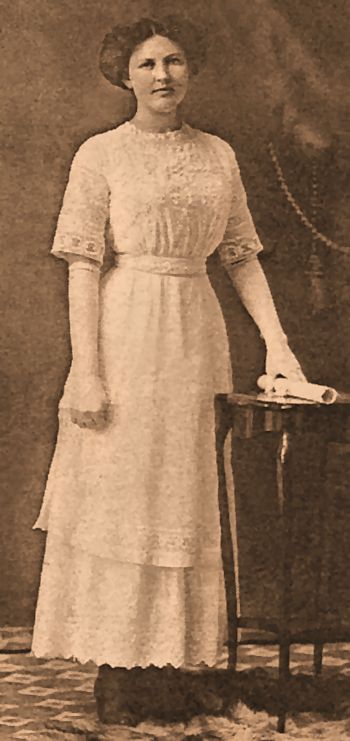
Kisten Adams Perkins, 1911 |
|
Kisten was asked by the bishop to serve on the Burial Committee in Blanding. If a sister or a child died in the ward, she would go into the home, prepare the body for burial, and sew the clothes for burial. Many times she worked through the night, comforting others with her embroidered handiwork on the beautiful clothes she made for their loved ones.
Kisten and Corry were heartbroken when they lost their oldest daughter, Merlene, when she was 15 years old. Four years later their oldest son, Bruce, died. Five years after that her husband, Corry, died and she was left a widow for the last 27 years of her life.
Her faith upheld her when her son, Calvin Perkins, was missing in action during World War II. Calvin was nineteen when he enlisted in the air force, and in what seemed no time at all, he was flying bombing missions over Germany in a Flying Fortress. His plane was hit by gunfire and the crew bailed out. Calvin received several severe wounds but managed to live through eight long months of captivity as a prisoner of war. He was released by Pattonís Army and after several months of rehabilitation, he was returned home.
|
|
|
In later years Kisten traveled to every temple then built, and did a session in each one. Kisten went to California on a mission where she was a companion with her youngest son, Jimmy, for a time.
At the age of 77, Kisten died on November 25, 1966 in Blanding, Utah, and is buried beside her husband, Hyrum Corry, in the Blanding Cemetery.
Extended Family History by Margaret Perkins Tennity
|
|
|
|
|
|
|
|
|

